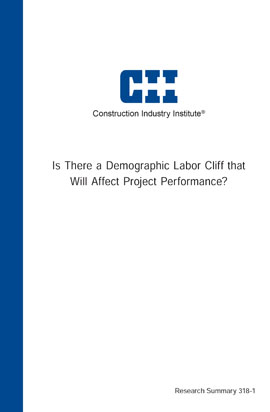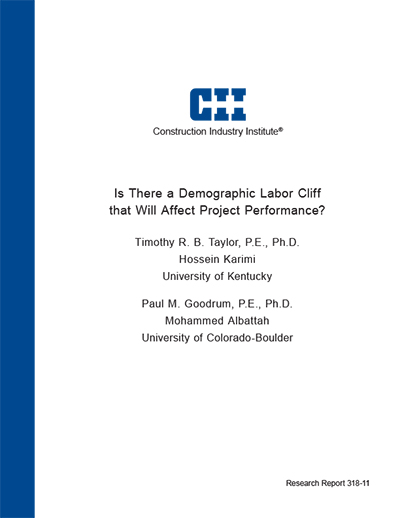
Is There a Demographic Craft Labor Cliff that Will Affect Project Performance?
After decades of facing periodic workforce challenges, many construction industry leaders seem to have become habituated to the idea of a looming skilled workforce cliff. With increasing concerns that imminent severe labor shortages could affect many projects—even as the industry continues its recovery from an economic downturn—the industry response is once again likely to be, “We’ll find the workers we need,” or “No shortage will exist if we pay enough.” While true to some extent, these statements are short-sighted and do not acknowledge the deeper problem.
CII chartered Research Team (RT) 318, Is There a Demographic Labor Cliff that Will Affect Project Performance, to determine whether the industry is in fact now facing a skilled labor cliff. The team found that such shortages are expected in the southwestern and southeastern United States among welders, pipefitters, and electricians. However, the more pressing issues are the long-term structural changes in the construction craft workforce, including the following:
- At a time when the wage gap between construction craft labor and all other industries has shrunk, construction craft workers are increasingly more motivated by higher wages than they are by job satisfaction.
- The average age of the construction craft workforce is increasing three times faster than the average age of workers in all other U.S. industries.
- Lack of educational attainment among the Hispanic workforce serves as a barrier to Hispanic workers moving into the higherskilled trades that are more in demand, such as welding, pipefitting, and electrical.
- The decline in career and technical education among high schools across the country and the emphasis on four-year degrees as a path to career success have contributed to the shortage of experienced high-skilled workers.
This research summary presents empirical project-based evidence that workforce shortages are directly correlated with at least three key elements of project execution:
- Safety – A labor shortage could cause OHSA TRIR rates on projects that range from 0.26 to 0.94, depending on the severity of the shortage.
- Cost – A labor shortage could cause project cost escalations of more than 17 percent, depending on the severity of the shortage.
- Schedule – A labor shortage could cause projects to experience schedule delays of more than 22 percent, depending on the severity of the shortage.
The research team used this analysis to develop Implementation Resource (IR) 318-2, Craft Risk/Availability Forecasting Tool (CRAFT), a predictive model to determine craft labor availability for specific projects. The team also produced Research Report (RR) 318-11, Is There a Demographic Labor Cliff that Will Affect Project Performance?, to document the research process in technical detail.
The skilled labor market for the construction industry has a serious structural problem, and the longer industry leaders erroneously assume that the market will take care of itself, the more severe the problem will become. All industry stakeholders must contribute to the solution. As the ultimate buyers of construction services, owners must demand robust workforce development efforts to level the playing field for labor providers. Labor providers must invest in establishing a skilled workforce pipeline to ensure a sufficient numbers of workers when and where they are needed. By diligently planning for their workforce needs earlier in the project planning process, all stakeholders can muster greater capacity to influence their projects’ labor components and more effectively manage labor risk.
Some regions of the U.S., especially in the Southwest and Southeast, are expected to experience severe pipefitter shortages while other areas will experience surplus labor conditions. Projections for welders and electricians are in the RT318 Research Report. (RS318-1, p. 3)
The figure below shows Future Pipefitter deficit/surplus for First Quarter 2018.The gap of real wages almost shrunk by half in 2014 when compared to 1974. The construction industry’s workers in 2014 earned $5.53/hr. less real income than in 1974, while the total private industries’ workers in 2014 earned $0.67/hr. less real income value as in 1974. (2014 Dollar Amount – Inflation Adjusted) (RS318, p. 10)
The figure below shows this gap for 2014 inflation-adjusted wages.(RS318-1, p. 21)
- Very severe – Staffing difficulties led to project delay
- Severe – Staffing difficulties led to delay of completing project milestones
- Moderate – Staffing difficulties led to delay of completing project activities on time
- Slight – Staffing difficulties led to consumption of schedule float and/or contingency
- No difficulty – There was any shortage. Able to staff the project with no delay on construction.



